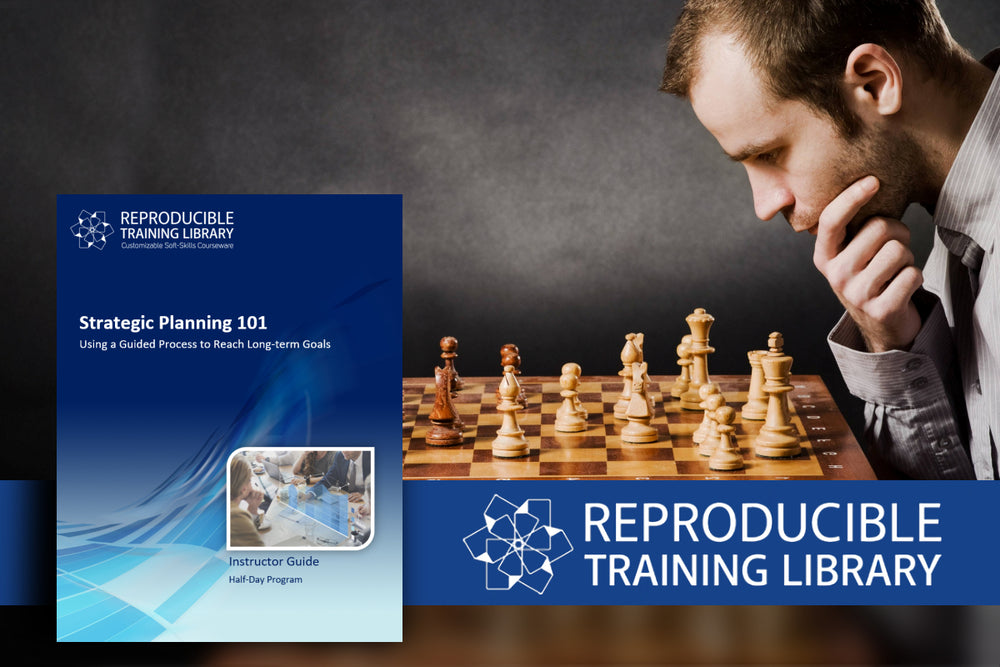Share
Strategic Planning: What Is It and How Does It Affect Leadership?
Bradford R. GlaserHave you ever felt like your group is going nowhere too fast? Many leaders have felt themselves in that position at one point or another. You might just find that strategic planning is the tool that can help you carve out a clear path for the future.
What does strategic planning mean, you ask? Well, it means setting goals and looking at both inside and outside factors and making good plans to meet those goals. People who are great at strategic planning can give you better direction and a clear plan to make smarter decisions.
This strategy has been helpful for a long time, too. It still holds value today; with strong strategic planning, leaders like you can better handle any problem that your organizations might face.
Let's talk about it!

- Focus team efforts on goals
- Align strategies with mission
- Develop action plan to monitor
Table of Contents
What Is Strategic Planning?
At the heart of it, strategic planning is all about what you want for the future and figuring out the goals and steps needed to get there.
This means you should set SMART (specific, measurable, achievable, relevant, and time-connected) goals. Take a good look at your latest situation and come up with new strategies. Then, you put those strategies into action and keep a close eye on them over both the short and long term.

Think about this: strategic planning is like mapping out a long trip. Have you ever planned a road trip? First, choose where you want to go (defining the vision). Then, plot out the exact path and stops along the way (setting goals and steps). It's important to also check how your car is doing and the road conditions (environmental analysis). Finally, you start the process but stay ready to change your path if you run into unexpected roadblocks (evaluation and adjustment).
Leadership, from my point of view, plays a big part in every step of strategic planning. Leaders need to set the direction and choose where to allocate resources. Besides, they need to make sure short-term goals match the general plan. You can see how strong leadership helps carry out these strategies! Leaders make sure everyone on the team knows and works towards the organization's set goals since this brings together a more united effort to get those set goals.
Do you know about the different tools and popular frameworks used in strategic planning? These tools include SWOT analysis, PESTEL analysis, and Balanced Scorecards. Each gives a very helpful way to create strong strategies. Just to give you an example, a SWOT analysis points out strengths, weaknesses, opportunities, and threats, which leads to better decisions.
Usually, strategic plans cover three to five years so they need regular check-ins to stay on track since this regular check-in process lets leaders change strategies and respond to changes in the market or within the company. Don't you agree that staying very flexible and changing plans is needed for long-term success?
How Does Strategic Planning Guide Decisions?
To see how strategic planning can change your leadership strategy, you need to understand how it matches your organization's vision with helpful and reachable goals. You should think of adding strategic planning to your leadership plan, like your roadmap. It guides you through short-term problems and keeps long-term goals in focus since it's pretty big for keeping stability and direction during uncertain times.
Think about it: the effect of strategic planning on decision processes is huge! It gives you a good framework. That makes it easier to make smart decisions and also reduces the risks that come with quick or emotional decisions. With tools like SWOT analysis and KPI tracking, then you end up in a better place. These tools help you find new chances and see possible dangers, which results in a proactive leadership style, not reactive.

Let's now move to another very important thing: how does strategic planning help with team alignment? Strategic planning creates a culture where everyone works hard toward the same goals. When you incorporate your team in the planning process, their commitment goes way up since this also improves their feeling of ownership over the big goals – it really helps.
Think about resource allocation, an area where strategic planning can turn your leadership. Strategic planning shows you how to correctly distribute resources (like the budget, staff, or time) in a way that closely matches your strategic priorities. Instead of spreading your resources too thin, you put attention to areas that promise the highest return to help with your organization's efficiency and performance.
Lastly, the metrics you set during strategic planning act as major benchmarks for checking progress. Regular checks let you track how you are doing against these goals. You can make needed changes then since this regular cycle of planning, doing, and looking closely at things improves your ability to lead and adapt quickly to changing situations!
Next, let's talk about how you can connect and better help your team.
How Can Leaders Involve Their Teams?
Having your team involved in the planning process has big pluses. It brings in different perspectives and gets more buy-in and commitment to the entire plan. So, why wouldn't you just want your team to feel more invested in where your organization is going? You can try helpful workshops and surveys and brainstorming sessions while keeping clear communication during the whole planning process.
First, set a tone that shows the worth of planning and gets all employees involved. When people see that you prioritize their input, they are more likely to join in and contribute. Define your organization's vision. Do all your team members get the organization's vision, mission, and values?
Next, set clear goals. Follow the SMART criteria – Specific, Measurable, Achievable, Relevant, and Time-Connected – to set clear targets. Being very clear helps your team see how their work directly leads to the organization's general success. Create a shared vision that also shows how each member fits into the bigger picture. Everyone's work needs to match these close goals.
What steps can you take next to make sure everyone stays on the same page? Start by creating regular dialogue, welcome questions, and create a place where open communication is encouraged! This clears up any uncertainties and improves general engagement.

Finally, set up regular chances for personal connections. Regular meetings or focus groups can build shared trust and create real bonds since this strategy makes sure regular engagement happens – it also continually lets continuous feedback help you adjust your plan as needed.
So, you should think about the effect of clear and steady communication. It solidifies all your goals and makes everyone feel part of this important process. How can you help yourself with these goals continually? Adding these regular practices into your leadership strategy makes the planning process more welcoming.
Clear and open communication isn't a job but a strategy that ties you and your team together. How could you not want to make your team feel more valuable? So, take all these steps, and you'll see the benefits show up in every part of your planning process.
Let's talk about some close problems that groups often face when they try to plan for the future.
What Are the Major Challenges in Strategic Planning?
When you talk about strategic planning, you'll often face a few major challenges that can throw your work off course if not handled right, so let's talk about them. One big problem is the lack of clear and specific goals. Without well-defined and easy targets, your strategic planning process can get aimless and wandering. I've seen it happen – again, make sure your goals are SMART (Specific, Measurable, Achievable, Relevant, and Time-Connected) to give you a clear roadmap for your team.
You also have to think about having enough data and doing the right analysis. These can be big roadblocks! In strategic planning, you need reliable data to make smart decisions. Invest in data tools and also create a culture that values data and helps make smart decisions. Ask yourself, what steps can you take to help with conversations and teamwork among team members?
Bad communication and poor collaboration can cause fragmented work and missed chances. And none of us want that. Make a clear communication plan and use collaboration platforms like Slack or Microsoft Teams to keep everyone up-to-date. Regular check-ins and feedback sessions make sure everyone stays on the same page.
Resistance to change is another big challenge. Change management strategies like regular training sessions and explaining the benefits of new ideas and changes can help reduce this resistance. Create a culture that's flexible and also open to new ideas.
Not having the right resources can also be a big challenge. I recommend you do a full audit of what resources are available and match them with your strategic priorities. The right budgeting and resource management are important for success.

Not being able to adapt to change can make your strategic plan useless. The market can shift quickly, so it's important to add flexibility to your plans. Welcome agility and responsiveness within your team since this way, you can adapt when you need to.
A lack of accountability and performance metrics can result in poorly executed plans. Set clear KPIs and assign roles to specific team members since this way, you can further track progress and hold everyone responsible for their work.
It's also worth not focusing too much on short-term gains. While immediate results matter, they shouldn't come at the cost of long-term success. Balance your focus to ensure the regular success of your strategic goals.
Weak leadership and an unclear vision can further harm your planning. Strong leaders make sure that the vision is communicated and that everyone is heading in the same direction. Invest in leadership programs to build these skills within your team.
Lastly, not being able to prioritize and focus scatters your work and dilutes the effect of your strategic plan. I recommend prioritization tools like the Eisenhower Matrix to keep an eye on what is most important. An organized and focused strategy will make sure that your resources and work are directed at where they will have the biggest effect.
How to Start Your Own Plan
Thinking about planning brings to mind how it mixes every detail of leading, and it sure gives both chances and many hurdles in equal amounts. You know, leaders who often talk about this process see the worth of setting clear goals. Build team collaboration and always keep a close eye on internal and external factors. Have you thought much about the steps you need to start this game-changing process for your own organization?
It doesn't have to be too scary, so always start small. Define your clear vision and set reachable goals. Incorporate your team from the very beginning! Always remember that the great magic of planning lies in its regular nature. The goal is constant improvement and positive change.
Getting started with your own plan can be easier with a good, helpful step-by-step strategy. Start by looking at your latest general position – this basically means you should see where your organization stands in the market and recognize strengths, weaknesses, and opportunities. Next, just create your helpful strategy. What path do you want to follow, and what are the best ways to get there? After that, write down your general strategy in a clear and easy-to-follow format. Whether it's a strategy map or a full plan, it's very important that everyone in your organization gets it.
Lastly, you should review and even change your strategy every now and again. As your organization then grows and the market often changes, your team at every step will then make sure that the plan isn't just top-down.

People who feel a bit overwhelmed by starting their planning process might want to think about getting expert advice further. Our company, HRDQ, has a helpful resource to help you with your planning skills. Our Strategic Planning 101 Customizable Courseware was built to give you and your team the basic skills needed since this powerful course covers everything from matching your general strategies with goals, looking at the latest and future states, and making helpful plans! Enable your team with insights and activities that help with efficiency, responsiveness, and general success.
We invite you to look into this chance more. Planning is not a one-time job but a process that grows with your organization. I think investing in helpful training can make a difference in how well your team works with this process. Ready to take the next important step in further improving your leadership and general organization? Let HRDQ help with our customized training services. Your successful planning process starts here!





















































